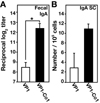Abbreviations
APC
C5aR
ELISA
CLSM
ELISPOT
FAE
FMDV
LP
PP
SC
SE
SIgA
SPL
UEA-1
WGA
Journal List > Immune Netw > v.13(4) > 1033381
APC
C5aR
ELISA
CLSM
ELISPOT
FAE
FMDV
LP
PP
SC
SE
SIgA
SPL
UEA-1
WGA
 | Figure 1Co1-mediated in vitro M cell-targeting of VP1 antigen of FMDV into mouse ileal PPs. In whole-mount ileal PPs, in vitro interactions between VP1 antigen and M cells were monitored by CLSM. VP1 or VP1-Co1 was detected by using anti-FMDV antibody and then by using FITC-conjugated secondary antibody (green). M cells were distinguished from enterocytes through interaction with UEA-1 (red) but not with WGA (blue). Whole-mount images were created using slices from z-stacks into one slice along the χ-turning axes by using an LSM image browser. Each scale bar represents 50µm. |
 | Figure 2Enhancement of Co1-mediated VP1-specific IgA response in the mucosal compartment. (A) The VP1-specific IgA level in the fecal extract of mice orally primed with each indicated antigen and then challenged with VP1 alone was measured through ELISA. The results were calculated as the reciprocal of the geometric mean log2 titer. (B) The number of VP1-specific IgA SCs in LP was analyzed by ELISPOT. Results are expressed as mean±SE per 106 cells of 5 mice per group. *p<0.05 indicates significant difference compared with the control VP1-immunized group. |
 | Figure 3Characterization of the cytokine expression pattern of lymphocytes after in vitro VP1 stimulation prepared from the mice orally immunized with each indicated antigen. The number of each indicated cytokine SC was analyzed by ELISPOT in PP (A) and LP (B) prepared at 10 days after systemic challenge with VP1 alone as described in Materials and Methods. *p<0.05 and ***p<0.001 indicate significant differences compared with the control VP1-immunized group. |
 | Figure 4Induction of efficient VP1-specific systemic immune response by oral priming of mice with Co1-conjugated VP1. The numbers of VP1-specific IgG SCs (A) and each indicated cytokine SC (B) in SPLs were analyzed by ELISPOT. Results are expressed as mean±SE per 106 cells of 5 mice per group. *p<0.05 indicates significant differences compared with the control VP1-immunized group. (C) Lymphocyte proliferation was measured by tritium incorporation after in vitro stimulation with VP1 antigen 10 days after systemic challenge. Results are expressed as stimulation indices calculated as described in Materials and Methods. *p<0.05 indicates significant differences compared with the control VP1-immunized group. |
APC
C5aR
ELISA
CLSM
ELISPOT
FAE
FMDV
LP
PP
SC
SE
SIgA
SPL
UEA-1
WGA